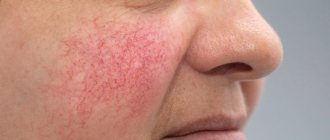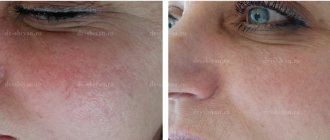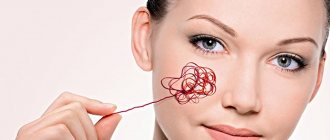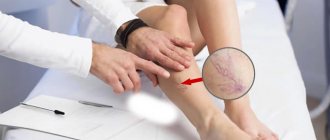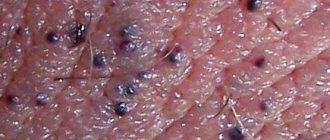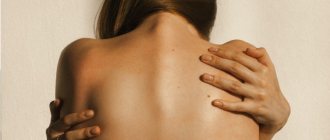Even the most minor skin defects can cause discomfort for a person. Among defects of this kind, it is worth highlighting spider veins (SV), which are called “telangiectasia”. The expansion of skin capillaries contributes to their appearance. Externally, this defect consists of cobwebs, dots or winding lines that are red-violet in color.
As a rule, telangiectasia appears more often in women. However, its development in men is also possible. The main areas that are most often affected by this defect are:
- chin;
- cheeks;
- wings of the nose;
- legs.
SZ are not the result of an inflammatory process in the body and do not cause pain to a person. If you press on the defect, it may become lighter or disappear altogether. However, after some time, the red-violet web will reappear on the skin under the influence of blood vessels filling.
SZ is not a health or life-threatening pathology. However, in some cases they represent symptoms of certain vascular diseases that require mandatory consultation with a specialist. If telangiectasia occurs, you can seek qualified advice from our medical doctors. Here, every patient is guaranteed to receive professional help.
What is this?
The vascular network is the result of a small intradermal expansion to which vessels of all types are exposed, losing their tone. Spider veins appear most often on the face, but they can also appear on other parts of the human body (abdomen, legs, thighs).
The pathology is characterized by a stable course. This means that the skin defect that appears in the form of SZ will not disappear on its own. To eliminate it, you need the help of a phlebologist or surgeon.
There are several types:
- Linear
, which in most cases appear on the face, less often on the skin of the inner thigh. - Tree-like
, most often appearing on the legs. - Point defects
can occur as an independent defect, or in combination with other types of telangiectasia. - Arachnids
, representing a large number of dilated capillaries that extend from the central artery and branch in different directions. Can affect different areas of the body.
Depending on the origin, the following SZ are distinguished:
- Arterial
, having a red tint and predominantly diverging in different directions from the main arteriole. - Venous
, the width of which is more than 0.02 mm. - Capillary
, in most cases, tree-like or linear stars appearing on the nose and cheeks.
Most often, people who are faced with this problem promptly seek help from specialists. However, there are cases when the appearance of SZ is ignored, or attempts are made to eliminate them independently. In the latter case, the risk of aggravating the situation is very high, because often telangiectasia is a symptomatic manifestation of varicose veins, which must certainly be treated only under the supervision of an experienced doctor.
Photo
Spider veins on the legs, face, shoulders and other places of the human body look extremely unaesthetic. This can cause discomfort, embarrassment and a drop in self-esteem. All this negatively affects a person’s quality of life. If you do not pay attention to this problem at the initial stage, it can worsen, and the NWs from small formations will turn into huge, immediately noticeable meshes of a bluish tint. Examples of what a pathological lesion looks like in various parts of the body are shown in the photo below.
Causes of spider veins
In most cases, the development of pathology is caused by disturbances in blood flow in the veins. However, the appearance of a vascular network does not always signal varicose veins. It can occur under the influence of many factors, which are both internal and external. Internal factors include:
- excess weight;
- pregnancy;
- diabetes;
- hormonal disbalance;
- use of glucocorticosteroid medications for a long time;
- pathological liver damage;
- lack of vitamin K or C, silicon, copper, ascorbic acid;
- genetic predisposition;
- varicose veins on the legs;
- connective tissue diseases;
- taking oral contraceptives;
- autoimmune pathologists, etc.
Spider veins - why do they appear? In response to this question, we should also list the external factors that provoke their formation:
- bad habits;
- prolonged nervous tension;
- radioactive exposure;
- constant physical activity;
- regular changes in ambient temperature;
- UV radiation;
- severe injuries and bruises.
All of the above aspects in one way or another affect the walls of blood vessels, resulting in a violation of their permeability. If we are talking about a pathological process caused by external factors, then it can disappear without any procedures aimed at its destruction. If SZ arose due to internal factors, then in this case medical intervention will be required.
Risk group
Phlebologists at risk for the formation of spider veins include:
- women (80% of cases are female);
- overweight people;
- persons over 80 years of age;
- people leading a passive lifestyle;
- patients whose daily activities involve severe physical activity and carrying heavy objects;
- people who spend a lot of time on their feet;
- patients forced to take hormonal drugs for a long time.
Places of education
Formations of this kind can appear on absolutely any part of the body. However, there are several of the most common areas of their occurrence:
- wings of the nose;
- cheeks;
- feet;
- ankles;
- anterior surface of the lower leg;
- popliteal region;
- middle third of the outer thigh.
Pathological formations can also, in rare cases, appear on the back, neck and arms. However, it is important to remember that, regardless of where the skin defects in the form of a vascular network are formed, it is necessary to consult a doctor in a timely manner. He will conduct an examination, on the basis of which it will be possible to determine their nature, make a diagnosis and prescribe treatment. If you leave SZ that appears on the human body without attention, you can provoke the development of more serious diseases of the venous system.
It is recommended to exclude any forms of self-medication in order to prevent an increase in the affected area of the SZ. You can count on a positive result only in case of therapy according to the recommendations and under the supervision of a professional doctor.
On foot
The appearance of telangiectasia on the legs in most cases may go unnoticed due to the absence of pain or another form of manifestation of its occurrence. This can lead to the pathology developing into an advanced form. As a result, swelling and a feeling of heaviness will appear in the lower extremities. If you ignore these manifestations of pathological disorders, the condition will noticeably worsen.
In fact, the formation of a defect in the legs is the first and quite serious sign of problems with blood vessels. The branches can vary in color and shape and are located on the lower limbs in groups or parallel to each other. Don't assume that the problem will solve itself. Treatment of spider veins on the legs should be carried out under the supervision of an experienced phlebologist. In honey you can definitely find qualified help in eliminating telangiectasia.
On the face
The vascular network on the skin in different areas of the face, otherwise called rosacea, is a signal of weakened and brittle blood vessels. As a rule, this defect appears on dry and sensitive skin. It is worth noting that eliminating this aesthetic imperfection is quite difficult.
Cuperosis is a cosmetic imperfection that occurs due to dilation of blood vessels, which can be traced through the skin in the form of cobwebs or stars. In most cases, imperfections appear on the chin, cheeks, and wings of the nose as a result of the loss of elasticity of the vessels under the influence of stress. This leads to stagnation of blood and their expansion.
Dermatologists distinguish the following stages of rosacea:
- The first
, manifested in the form of irritation due to prolonged exposure to an environment with high air temperatures and dry air. In this case, it is appropriate to talk about the local nature of the problem. - The second
, in which dilated capillaries located in the vicinity begin to merge into a single network. This stage is characterized by a brighter color of the vessels. - The third
, characterized by a greater severity of the capillary network and redness. - Fourth
. At this stage, not only small vessels, but also all other vessels on the face are susceptible to pathological effects. This leads to the appearance of areas of local blanching of the skin and clearly visible capillaries.
Laser
This technique uses laser radiation of a special frequency. The laser beam allows you to glue, solder and sclerosis the veins that make up the cosmetic defect. It is worth noting that despite its popularity, the technique has obvious disadvantages. The procedure is accompanied by a significant thermal effect on the skin with burning of the entire star pattern, whereas with sclerotherapy the sclerosant is injected and distributed through one injection point. With laser exposure, it is not always possible to close the “feeding veins,” which can lead to the rapid appearance of new subcutaneous patterns.
Diseases in which spider veins form
Telangiectasia, which is congenital, acts as a symptom indicating the presence of certain diseases in a person. Among them are ataxia-telangiectasia (Louis-Bar syndrome) and Rondu-Osler disease, which provokes a disorder in the development of the vascular endothelium. Both diseases are inherited.
Acquired pathology is the source of a number of dermatological problems. It may also indicate the presence of Rosacea, a chronic dermatosis. The disease occurs with the appearance of vascular disorders on the face (in the nasolabial folds, as well as in the corners of the eyes and nose).
Spider veins, the photo of which clearly demonstrates how much they spoil the appearance of the areas where they appear, can also be a manifestation of systemic connective tissue diseases. Their appearance is possible in the presence of liver disease. Its cirrhosis leads to disruption of hepatic blood flow and increased pressure in the blood vessels. As a result, the subcutaneous capillaries expand and corresponding rashes appear on the skin.
Chronic insufficiency occurs due to a violation of the venous outflow of the legs. The appearance of SZ on them is the first of six stages in the development of this disease.
Which doctor should I contact?
As soon as vascular networks appear on any part of the body, you should go for an examination to a therapist. He will conduct a number of necessary studies, based on the results of which he will be able to determine the nature of the defects that have appeared. If indicated, the therapist may refer the patient to:
- ophthalmologist;
- endocrinologist;
- cardiologist;
- gynecologist;
- neurologist.
If you have any accompanying symptoms, you should contact a specialist in the appropriate field. For example, if a person suspects that the problem is of a dermatological nature, then he will need to consult a dermatologist. If telangiectasia is accompanied by nausea, sudden weight loss, or a feeling of heaviness in the right hypochondrium, the person will need to consult a hepatologist or gastroenterologist. It is recommended to make an appointment with a rheumatologist for autoimmune diseases. A phlebologist surgeon eliminates SZ surgically.
Diagnostics
Treatment of spider veins should be preceded by diagnosis. A phlebologist will help accurately diagnose the disease and the stage of its development. The appointment will begin with a conversation with the patient, his external examination and palpation of the limbs. This will help the specialist to draw a conclusion about the area where the protective zone is located and the nature of the problem.
At the next stage, the doctor prescribes an examination. As a rule, it includes ultrasound duplex scanning aimed at:
- assessment of the condition of capillaries;
- identification of pathology and its location;
- study of the speed and direction of blood flow.
The conducted research will help the phlebologist draw conclusions about the person’s condition. In order to obtain more information about the patient's health, the doctor may order examination of other organs and ask him to take specific tests. To obtain more accurate information, establish concomitant diseases and the causes of telangiectasia, additional examination may be necessary:
- liver;
- hearts;
- thyroid gland;
- reproductive system.
Treatment
External imperfections in the form of spider veins on the skin can be easily removed in the early stages of development. But at the same time, it is important to remember that you need to get rid of not only the external manifestations of the pathology, but also the internal causes that provoke its occurrence. If the doctor, due to lack of sufficient experience or for some other reason, does not provide therapy at the proper level, this will cause the problem to progress and become more serious.
The fight against a skin defect that appears due to dilated blood vessels should consist of surgical manipulations and drug treatment. Prescription of drugs should be carried out exclusively by a professional doctor, taking into account the characteristics of the body of each individual patient.
Surgical procedures include:
- Phlebectomy, which is a common procedure that involves removing a vein. It allows you to redistribute blood flow to deep vessels that can withstand heavy loads. It is carried out only under anesthesia.
- Adhesive obliteration and sclerotherapy, during which various compounds are introduced into the capillary to promote gluing of the walls. This leads to the disappearance of the varicose area. Operations are characterized by high speed.
- Endovasal laser coagulation and radiofrequency ablation, during which the vessel is heated to a temperature above 100 degrees. This provokes the destruction of its internal walls and its subsequent disappearance.
In order to decide how to remove spider veins on the legs or other areas of the human body, you need to make an appointment with a highly qualified specialist. By contacting our Yuzhny clinic, you can count on a professional examination and selection of treatment methods that will be effective in your particular case.
Exercises
We have selected for you the simplest and most effective options for physical activity that will ensure sufficient blood circulation in the legs, relieve tension, relax muscles and help prevent the formation of asterisks.
- Standing. We walk in place without lifting the tips of our toes from the floor (up to 2 minutes)
- Standing. As you inhale, raise your arms up to your sides. At the same time, stand on your toes. As you exhale, lower your heels. Bend your knees slightly. Put your hands down. At the same time, stand on your toes. As you exhale, lower yourself onto your heels. Bend your knees slightly. Lower your arms (up to 10 times)
- Standing. Take one leg back. Stay in this position for a few seconds. Repeat with the other leg too. (up to 10 times)
- Jumping rope (up to 10 minutes).
- Sitting. Legs stand together. Raise one leg towards your chest. Hands hold your knee. Return to the starting position. Alternately with the right and left foot. (up to 10 times on each leg).
- Sitting or lying down. Place your legs straight on a stand above the level of sitting or lying down. Relax for 10-20 minutes.
- Lying on your back. Straighten your legs and rotate them in the same way as you would when riding a bicycle.
- Use only your feet and toes to pick up small objects on the floor.
- Sitting. Place your legs at 90 degrees. Slowly raise your heels as high as possible without lifting your toes off the floor. Perform the exercise for both legs and separately for each (10 times)
- Sitting on a chair. Straighten your legs. Rest on your heels. Stretch your toes towards you. Initial position. (up to 10 times).
- Sitting or lying down. Alternately bend and straighten your toes (up to 10 times).
- Sitting or lying down. Lift your heels off the floor and cross your straightened legs (up to 10 times).
- Lying on your back. Raise your straightened legs perpendicular to the floor. Take turns bending and straightening your knees (up to 10 times)
- Lying on your back. Press your shoulders and elbows to the floor. Using your palms to keep your hips raised, rotate your shins. Don't lift your feet off the floor.
- Lying on your back. Straighten your legs. Pull the toe towards you. Then from myself. Alternately with each leg. (up to 10 times)
How to remove spider veins?
To remove telangiectasia as a cosmetic defect, many painless procedures that do not require surgery are used today. The most common among them are:
- Sclerosis. It involves the introduction of a special solution into the vessel, which causes its walls to stick together and gradually dissolve.
- Ozone therapy.
- Laser coagulation and more.
Remedies for spider veins also include various ointments and creams. However, only an experienced phlebologist should select a method that will be effective in eliminating SZ in each specific case. In this case, the scale of damage to the skin by the vascular network, the thickness of the vessel and other aspects are taken as a basis.
Any of the listed methods for eliminating external imperfections must be combined with drug treatment. This will eliminate not only the external manifestation of the pathological process, but also eliminate its internal causes. An integrated approach guarantees restoration of the vascular condition to normal and reduction or complete elimination of the manifestations of venous insufficiency.
Laser removal
Laser removal of spider veins both on the legs and face consists of several stages:
- The client contacts a specialist for a consultation, during which he receives detailed information about the procedure, and the doctor identifies the presence of contraindications and answers the patient’s questions.
- Direct manipulation. It is painless, but local anesthesia can be given at the patient's request. The specialist adjusts the laser in a certain way, based on the characteristics of the formations, and then begins processing the detective zones. Laser beams have a destructive effect only on hemoglobin and oxyhemoglobin cells. As a result, the stars are removed.
- Receive recommendations to follow during the recovery period. The patient should avoid prolonged exposure to the sun for at least 3 days after the procedure. You also need to avoid cosmetics and procedures that injure the skin.
Contraindications:
- Pregnancy and lactation.
- Taking medications that increase the sensitivity of the dermis to light.
- Types 1 and 2 diabetes mellitus.
Ointments and creams
Cream and ointment for spider veins are topical preparations. The breadth of their assortment on the modern market determines the difficulties that people face when choosing them independently. A qualified phlebologist will help you cope with this task; you can make an appointment with him in our medical office.
External use products are intended to eliminate visual problems, combat symptoms and prevent the progression of formations. They stimulate blood flow, increase vascular tone, eliminate blood stagnation and strengthen capillary walls. This effect is achieved by adding to the preparations:
- Thermal water;
- Nutrients;
- Vitamins;
- Phlebotonics;
- Plant extracts.
It is prohibited to apply ointments and creams for spider veins to areas of skin with redness, wounds and rashes. External medications for telangiectasia are indicated for people with impaired blood clotting.
Sclerotherapy (microsclerotherapy)
We perform the procedure on an outpatient basis without hospitalization, without incisions and without pain. Duration about an hour. Minimum restrictions. Treat the skin at the injection site with an antiseptic (alcohol wipe). A special liquid or foamed preparation – sclerosant – is injected into the dilated visible saphenous vein and the feeding branches that make up the defect through a thin needle (insulin syringe). It causes adhesion, gluing and sclerosis of the vein walls. Due to these effects, we turn off damaged vessels from the bloodstream. The Veinlite device allows us to visualize the veins well.
For sclerotherapy, we use the best products Fibro-Vayne or Athoxysklerol.
If there are a large number of stars, additional injections may be necessary to achieve optimal results.
Next, we apply special gauze pads to the areas of sclerosant injection and put on compression stockings for 3-4 days. Compression therapy allows you to reduce venous pressure and accelerate the necessary initial gluing of the walls of the asterisk vessels. The level and duration of compression pressure is determined individually.
After sclerotherapy, the rehabilitation period is short. As a rule, there is no need to take sick leave. You will be pleasantly surprised when you see how quickly there is no trace left of the star. In the long term, an excellent, lasting aesthetic effect is preserved. It is very important to follow all our recommendations after the procedure. Our professionalism, concentration and experience will allow you to be confident in the results. Grateful reviews from our patients confirm that we are on the right track. We will do everything to make you satisfied.
Treatment of spider veins at home
Before answering the question “how to remove spider veins at home?”, you should take into account that this can only be done in the early stages of their appearance. In this case, you will have to strictly implement a whole range of measures in order to achieve a positive result. It is impossible to completely get rid of SZ that formed a long time ago at home; you will need the help of a specialist.
You can eliminate the vascular network on the face at home using various decoctions of medicinal herbs, which should be used to regularly wipe the skin. In order to cope with the same problem that has arisen on the legs, you need to carry out various gymnastic exercises throughout the day that will make the blood circulate at a faster speed. It would be better to replace trips with walking.
Can self-medication help?
As a rule, this does not give the desired effect. A comprehensive examination, consultation with a phlebologist and development of a treatment plan are required. Very often you come across information that seriously talks about the possibility of getting rid of star veins using folk recipes (apple cider vinegar, pine and flower baths, Kalanchoe infusion, tomato compress). We don’t think that this is the correct and rational solution to the problem for you and we don’t recommend experimenting on your patience and health.

